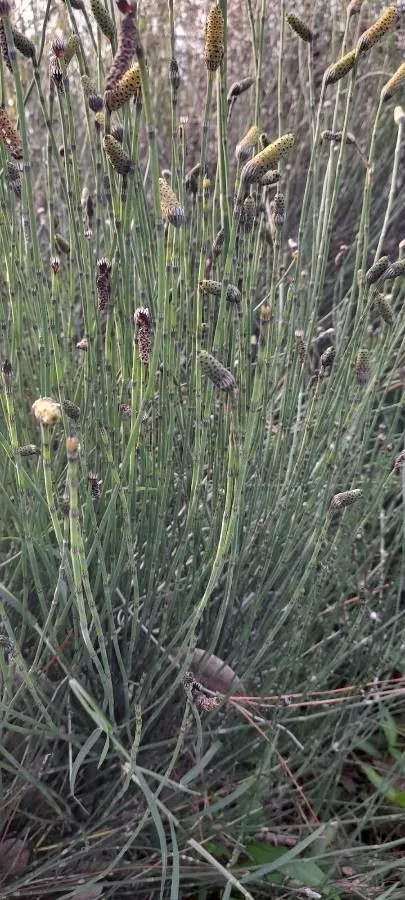
Author: L.
Bibliography: Syst. nat. ed. 10, 2:1318. 1759
Year: 1759
Status: accepted
Rank: species
Genus: Equisetum
Vegetable: False
Observations: Trop. & Subtrop. America
The Giant horsetail, known by its scientific name Equisetum giganteum, is a remarkable species within the Equisetaceae family. Described by prominent botanist Carl Linnaeus in the pivotal publication “Systema Naturae” in its 10th edition, this particular plant has continued to captivate botanists and naturalists alike since it was first documented in 1759.
Equisetum giganteum thrives in tropical and subtropical regions of the Americas, where it forms dense, lush stands that can often be found near wetlands, stream beds, and other moist habitats. The plant is notable for its towering stature, which can surpass that of its relatives, growing to extraordinary heights that give it its common name. The Giant horsetail’s stem, segmented and hollow, showcases a striking green hue and often bears a rough, brush-like texture, reflecting its evolutionary lineage among some of the planet’s earliest plant forms.
This horsetail’s presence is vital within its ecosystem, contributing to both soil stabilization and water filtration. Its ancient lineage, marked by its primitive vascular system and reproductive spores, rather than seeds, speaks to its resilience and adaptability, traits that have allowed Equisetum giganteum to endure across millennia.
For those intrigued by botanical history, the Giant horsetail offers a living window into the deep past of the plant kingdom, connecting us tangibly with a world that existed long before the age of flowering plants. Its robust, bamboo-like appearance conceals a complex structure and represents a group of plants that were once dominant on Earth, offering invaluable insights into plant evolution and natural history.
Eng: giant horsetail, southern giant horsetail
En: Giant horsetail, Southern Giant Horsetail
Ar: كنباث عملاق
Zh: 巨木賊
Fr: Prêle géante
Is: Risaeski
Qu: Hatun kawallu chupa
Es: Cola de caballo
Ta: மிகப் பெரிய குதிரைவால் செடி
Taken Jan 1, 1900 by EOL − Frank Vincentz (cc-by-sa)
Taken Jan 1, 1900 by EOL − Frank Vincentz (cc-by-sa)
Taken May 13, 2021 by Trap Hers (cc-by-sa)
Taken Nov 18, 2022 by Trap Hers (cc-by-sa)
Taken Jan 29, 2022 by Trap Hers (cc-by-sa)
Taken Mar 23, 2021 by Trap Hers (cc-by-sa)
Taken Jan 29, 2022 by Trap Hers (cc-by-sa)
Taken Nov 18, 2022 by Trap Hers (cc-by-sa)
© copyright of the Board of Trustees of the Royal Botanic Gardens, Kew.
© copyright of the Board of Trustees of the Royal Botanic Gardens, Kew.
© copyright of the Board of Trustees of the Royal Botanic Gardens, Kew.
Taken Jan 29, 2022 by Trap Hers (cc-by-sa)
Taken Nov 18, 2022 by Trap Hers (cc-by-sa)
Taken Nov 22, 2021 by Alejandro Balbuena (cc-by-sa)
Taken Jan 1, 1900 by EOL − Frank Vincentz (cc-by-sa)
Taken Feb 23, 2021 by — coto mujica (cc-by-sa)
Taken Jan 27, 2021 by Franco Flavia (cc-by-sa)
Taken Jun 5, 2021 by Carlos Chiroy (cc-by-sa)
Taken May 13, 2020 by Cortés Verania (cc-by-sa)
Taken Nov 4, 2022 by pradenas villalobos (cc-by-sa)
Taken Dec 3, 2022 by Sofìa Varela (cc-by-sa)
Taken Jan 29, 2022 by Trap Hers (cc-by-sa)
Taken May 13, 2021 by Trap Hers (cc-by-sa)
Taken Mar 23, 2021 by Trap Hers (cc-by-sa)
Growth habit>: Forb/herb
Ph maximum: 7.5
Ph minimum: 7.0
Light: 7
Atmospheric humidity: 7
Soil nutriments: 4
Family: Myrtaceae Author: (F.Muell.) K.D.Hill & L.A.S.Johnson Bibliography: Telopea 6: 402 (1995) Year: 1995 Status:…
Family: Rubiaceae Author: Pierre ex A.Froehner Bibliography: Notizbl. Bot. Gart. Berlin-Dahlem 1: 237 (1897) Year:…
Family: Sapindaceae Author: Koidz. Bibliography: J. Coll. Sci. Imp. Univ. Tokyo 32(1): 38 (1911) Year:…
Family: Asteraceae Author: A.Gray Bibliography: Pacif. Railr. Rep.: 107 (1857) Year: 1857 Status: accepted Rank:…
Family: Fabaceae Author: Medik. Bibliography: Vorles. Churpfälz. Phys.-Ökon. Ges. 2: 398 (1787) Year: 1787 Status:…
Family: Aspleniaceae Author: (Cav.) Alston Bibliography: Bull. Misc. Inform. Kew 1932: 309 (1932) Year: 1932…